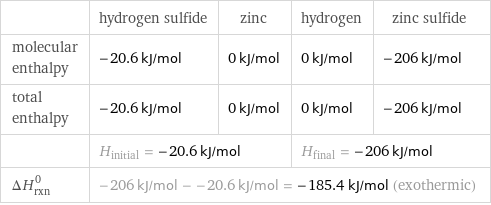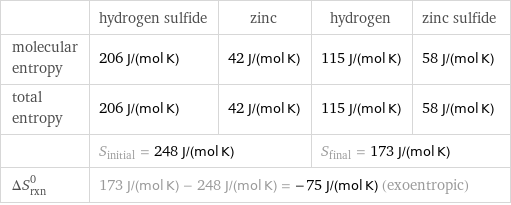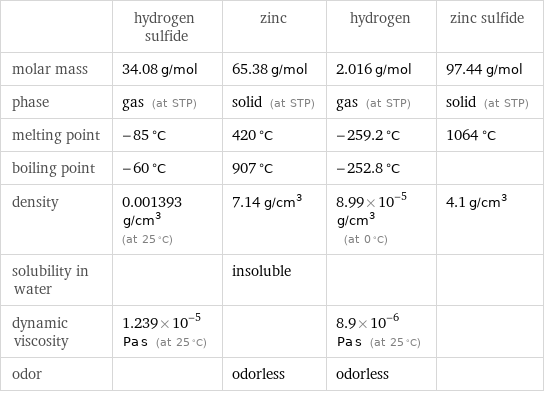Input interpretation

H_2S hydrogen sulfide + Zn zinc ⟶ H_2 hydrogen + ZnS zinc sulfide
Balanced equation

Balance the chemical equation algebraically: H_2S + Zn ⟶ H_2 + ZnS Add stoichiometric coefficients, c_i, to the reactants and products: c_1 H_2S + c_2 Zn ⟶ c_3 H_2 + c_4 ZnS Set the number of atoms in the reactants equal to the number of atoms in the products for H, S and Zn: H: | 2 c_1 = 2 c_3 S: | c_1 = c_4 Zn: | c_2 = c_4 Since the coefficients are relative quantities and underdetermined, choose a coefficient to set arbitrarily. To keep the coefficients small, the arbitrary value is ordinarily one. For instance, set c_1 = 1 and solve the system of equations for the remaining coefficients: c_1 = 1 c_2 = 1 c_3 = 1 c_4 = 1 Substitute the coefficients into the chemical reaction to obtain the balanced equation: Answer: | | H_2S + Zn ⟶ H_2 + ZnS
Structures

+ ⟶ +
Names

hydrogen sulfide + zinc ⟶ hydrogen + zinc sulfide
Reaction thermodynamics
Enthalpy

| hydrogen sulfide | zinc | hydrogen | zinc sulfide molecular enthalpy | -20.6 kJ/mol | 0 kJ/mol | 0 kJ/mol | -206 kJ/mol total enthalpy | -20.6 kJ/mol | 0 kJ/mol | 0 kJ/mol | -206 kJ/mol | H_initial = -20.6 kJ/mol | | H_final = -206 kJ/mol | ΔH_rxn^0 | -206 kJ/mol - -20.6 kJ/mol = -185.4 kJ/mol (exothermic) | | |
Entropy

| hydrogen sulfide | zinc | hydrogen | zinc sulfide molecular entropy | 206 J/(mol K) | 42 J/(mol K) | 115 J/(mol K) | 58 J/(mol K) total entropy | 206 J/(mol K) | 42 J/(mol K) | 115 J/(mol K) | 58 J/(mol K) | S_initial = 248 J/(mol K) | | S_final = 173 J/(mol K) | ΔS_rxn^0 | 173 J/(mol K) - 248 J/(mol K) = -75 J/(mol K) (exoentropic) | | |
Equilibrium constant
![Construct the equilibrium constant, K, expression for: H_2S + Zn ⟶ H_2 + ZnS Plan: • Balance the chemical equation. • Determine the stoichiometric numbers. • Assemble the activity expression for each chemical species. • Use the activity expressions to build the equilibrium constant expression. Write the balanced chemical equation: H_2S + Zn ⟶ H_2 + ZnS Assign stoichiometric numbers, ν_i, using the stoichiometric coefficients, c_i, from the balanced chemical equation in the following manner: ν_i = -c_i for reactants and ν_i = c_i for products: chemical species | c_i | ν_i H_2S | 1 | -1 Zn | 1 | -1 H_2 | 1 | 1 ZnS | 1 | 1 Assemble the activity expressions accounting for the state of matter and ν_i: chemical species | c_i | ν_i | activity expression H_2S | 1 | -1 | ([H2S])^(-1) Zn | 1 | -1 | ([Zn])^(-1) H_2 | 1 | 1 | [H2] ZnS | 1 | 1 | [ZnS] The equilibrium constant symbol in the concentration basis is: K_c Mulitply the activity expressions to arrive at the K_c expression: Answer: | | K_c = ([H2S])^(-1) ([Zn])^(-1) [H2] [ZnS] = ([H2] [ZnS])/([H2S] [Zn])](../image_source/de4a60bd52924bb1f424ae55992dc0b3.png)
Construct the equilibrium constant, K, expression for: H_2S + Zn ⟶ H_2 + ZnS Plan: • Balance the chemical equation. • Determine the stoichiometric numbers. • Assemble the activity expression for each chemical species. • Use the activity expressions to build the equilibrium constant expression. Write the balanced chemical equation: H_2S + Zn ⟶ H_2 + ZnS Assign stoichiometric numbers, ν_i, using the stoichiometric coefficients, c_i, from the balanced chemical equation in the following manner: ν_i = -c_i for reactants and ν_i = c_i for products: chemical species | c_i | ν_i H_2S | 1 | -1 Zn | 1 | -1 H_2 | 1 | 1 ZnS | 1 | 1 Assemble the activity expressions accounting for the state of matter and ν_i: chemical species | c_i | ν_i | activity expression H_2S | 1 | -1 | ([H2S])^(-1) Zn | 1 | -1 | ([Zn])^(-1) H_2 | 1 | 1 | [H2] ZnS | 1 | 1 | [ZnS] The equilibrium constant symbol in the concentration basis is: K_c Mulitply the activity expressions to arrive at the K_c expression: Answer: | | K_c = ([H2S])^(-1) ([Zn])^(-1) [H2] [ZnS] = ([H2] [ZnS])/([H2S] [Zn])
Rate of reaction
![Construct the rate of reaction expression for: H_2S + Zn ⟶ H_2 + ZnS Plan: • Balance the chemical equation. • Determine the stoichiometric numbers. • Assemble the rate term for each chemical species. • Write the rate of reaction expression. Write the balanced chemical equation: H_2S + Zn ⟶ H_2 + ZnS Assign stoichiometric numbers, ν_i, using the stoichiometric coefficients, c_i, from the balanced chemical equation in the following manner: ν_i = -c_i for reactants and ν_i = c_i for products: chemical species | c_i | ν_i H_2S | 1 | -1 Zn | 1 | -1 H_2 | 1 | 1 ZnS | 1 | 1 The rate term for each chemical species, B_i, is 1/ν_i(Δ[B_i])/(Δt) where [B_i] is the amount concentration and t is time: chemical species | c_i | ν_i | rate term H_2S | 1 | -1 | -(Δ[H2S])/(Δt) Zn | 1 | -1 | -(Δ[Zn])/(Δt) H_2 | 1 | 1 | (Δ[H2])/(Δt) ZnS | 1 | 1 | (Δ[ZnS])/(Δt) (for infinitesimal rate of change, replace Δ with d) Set the rate terms equal to each other to arrive at the rate expression: Answer: | | rate = -(Δ[H2S])/(Δt) = -(Δ[Zn])/(Δt) = (Δ[H2])/(Δt) = (Δ[ZnS])/(Δt) (assuming constant volume and no accumulation of intermediates or side products)](../image_source/b30596d838c9ef0337c5388aeebe01ff.png)
Construct the rate of reaction expression for: H_2S + Zn ⟶ H_2 + ZnS Plan: • Balance the chemical equation. • Determine the stoichiometric numbers. • Assemble the rate term for each chemical species. • Write the rate of reaction expression. Write the balanced chemical equation: H_2S + Zn ⟶ H_2 + ZnS Assign stoichiometric numbers, ν_i, using the stoichiometric coefficients, c_i, from the balanced chemical equation in the following manner: ν_i = -c_i for reactants and ν_i = c_i for products: chemical species | c_i | ν_i H_2S | 1 | -1 Zn | 1 | -1 H_2 | 1 | 1 ZnS | 1 | 1 The rate term for each chemical species, B_i, is 1/ν_i(Δ[B_i])/(Δt) where [B_i] is the amount concentration and t is time: chemical species | c_i | ν_i | rate term H_2S | 1 | -1 | -(Δ[H2S])/(Δt) Zn | 1 | -1 | -(Δ[Zn])/(Δt) H_2 | 1 | 1 | (Δ[H2])/(Δt) ZnS | 1 | 1 | (Δ[ZnS])/(Δt) (for infinitesimal rate of change, replace Δ with d) Set the rate terms equal to each other to arrive at the rate expression: Answer: | | rate = -(Δ[H2S])/(Δt) = -(Δ[Zn])/(Δt) = (Δ[H2])/(Δt) = (Δ[ZnS])/(Δt) (assuming constant volume and no accumulation of intermediates or side products)
Chemical names and formulas

| hydrogen sulfide | zinc | hydrogen | zinc sulfide formula | H_2S | Zn | H_2 | ZnS Hill formula | H_2S | Zn | H_2 | SZn name | hydrogen sulfide | zinc | hydrogen | zinc sulfide IUPAC name | hydrogen sulfide | zinc | molecular hydrogen | thioxozinc
Substance properties

| hydrogen sulfide | zinc | hydrogen | zinc sulfide molar mass | 34.08 g/mol | 65.38 g/mol | 2.016 g/mol | 97.44 g/mol phase | gas (at STP) | solid (at STP) | gas (at STP) | solid (at STP) melting point | -85 °C | 420 °C | -259.2 °C | 1064 °C boiling point | -60 °C | 907 °C | -252.8 °C | density | 0.001393 g/cm^3 (at 25 °C) | 7.14 g/cm^3 | 8.99×10^-5 g/cm^3 (at 0 °C) | 4.1 g/cm^3 solubility in water | | insoluble | | dynamic viscosity | 1.239×10^-5 Pa s (at 25 °C) | | 8.9×10^-6 Pa s (at 25 °C) | odor | | odorless | odorless |
Units
